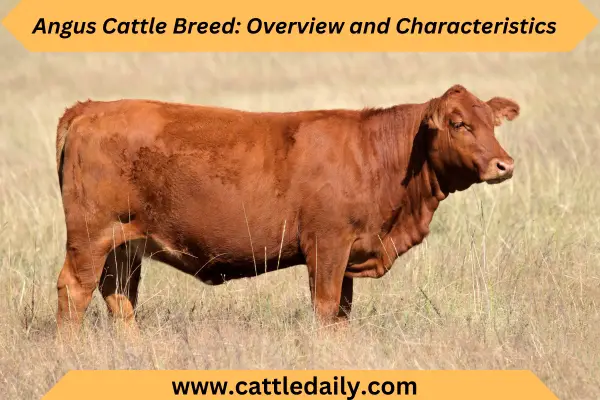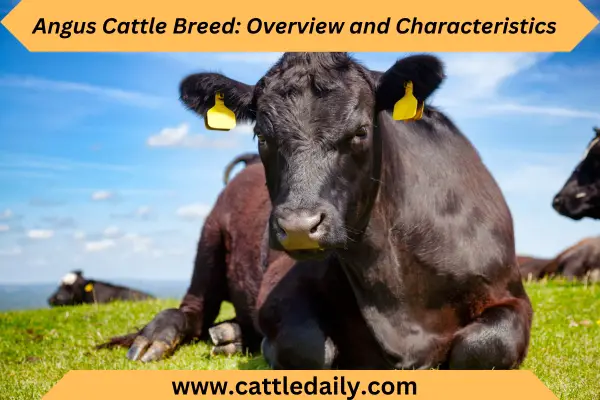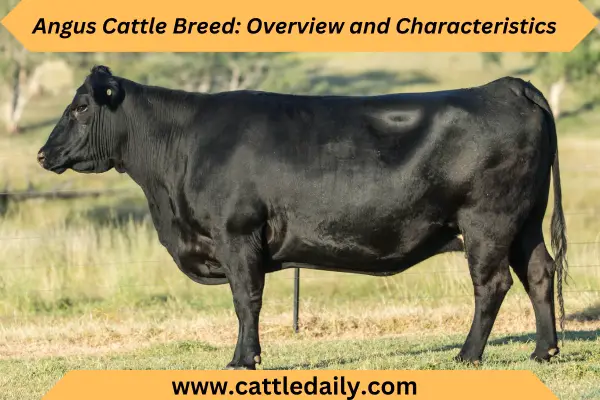Angus Cattle Breed: Overview and Characteristics
The Angus cattle breed is one of the most popular beef cattle breeds in the United States and worldwide. Known for their high-quality marbled beef, Angus cattle are an economically important cattle breed. In this article, we will discuss a brief history, key characteristics, and main uses.
A Brief History of Angus Cattle
Among the most influential modern cattle breeds, Angus cattle trace their origins to northeast Scotland in the counties of Aberdeenshire and Angus. They are the oldest registered breed of beef cattle worldwide.
The polled, solid black cattle native to the Scottish regions of Aberdeen and Angus were originally known as “Aberdeen Angus.” These hardy cattle were uniquely adapted to the harsh climate and terrain of northeast Scotland.
Angus cattle first arrived in the United States from Scotland in 1873, when George Grant imported four Angus bulls to Victoria County in Kansas. These cattle performed well, creating demand for additional imports of registered Angus to improve American cattle herds.
By 1883, American Angus enthusiasts formed the American Aberdeen-Angus Breeders’ Association in Chicago to maintain purity of the breed’s genetics through registration. The organization published the first Angus herd book in 1886 and later became the American Angus Association.
Over the decades, the American Angus Association has grown into the largest beef cattle registry in the world. From a small pool of initial imports, Angus cattle numbers have flourished across the United States and over 60 nations worldwide.
Through meticulous breed preservation and promotion by the Association, Angus cattle have gained mainstream popularity for their premium beef qualities. The consistent genetics, meat quality traits, and wide adaptability of Angus cattle make them one of the most influential modern breeds.

Key Characteristics and Traits of Angus Cattle
Black Coat and Polled Heads
The most distinguishing physical characteristic of Angus cattle is their solid black coat, devoid of any white markings. Angus cattle naturally lack horns due to being polled, meaning they have no horns or scurs on their heads. This hornless trait is inherited as an autosomal dominant gene. Polled Angus cattle do not require dehorning.
Excellent Marbling and Meat Quality
Angus cattle are renowned for their ability to marinate intramuscular fat within the muscle tissue. This fine marbling texture results in more tender, flavorful beef compared to other cattle breeds.
The abundant intramuscular fat also keeps Angus beef juicy and enhances palatability. Certified Angus Beef (CAB) specifications require a marbling score of Small or higher.
High Feed Efficiency
Angus cattle efficiently convert feed into lean muscle gain. They require less feed per pound of gain compared to larger-framed cattle breeds. Angus cattle have lower overall feed intake requirements due to their moderately small frame size. This makes Angus an economically favorable breed for beef production.
Calving Ease and Maternal Instincts
Angus cows exhibit calving ease, meaning they can give birth quickly and easily with minimal human assistance. This is partly due to the smaller calf size of Angus cattle. Angus mothers are also attentive and protective of their newborn calves, demonstrating strong maternal instincts.
Docile Temperament
Angus cattle are renowned for their docile, calm temperament. This makes them easier to handle and manage in feedlots. Their mellow disposition also contributes to high-quality beef, as calmer cattle have lower stress levels. Angus cattle have an innate gentle nature.
High Carcass Yield
Angus beef cattle have a high dressing percentage, meaning a greater ratio of carcass weight to live weight. More of their live body weight converts into usable retail cuts of beef and less into waste, bone, and fat. Angus carcasses yield well.
Climate Adaptability
Angus cattle thrive in varied climates and environments, from the hot southern states to the colder northern regions of the US. Their solid black coat color provides heat tolerance. Their coat also offers UV protection and insulation during winter.
Disease Resistance
Angus cattle have strong genetic resistance to common diseases affecting cattle, including pink eye and foot rot. This hardiness and ability to withstand health disorders make Angus suitable for extensive grazing systems.
Early Maturity
Angus cattle reach puberty early and have the ability to breed at a younger age. Angus heifers can be bred by 15 months of age due to their early sexual maturity. This provides flexibility in breeding programs.

Uses and Production
Angus cattle are a versatile breed used for various purposes worldwide. Some of the main uses and production systems for Angus cattle include:
Beef Production
The majority of Angus cattle are raised specifically for high-quality beef production. Their finely marbled meat is marketed under brand name programs like Certified Angus Beef (CAB) to capitalize on their premium genetics. CAB acceptance specifications include a Small or higher marbling score.
Both purebred registered Angus and Angus-cross cattle contribute to Angus beef production. Some common crosses include Black Baldies from breeding Angus cows to Hereford bulls. Angus-cross cattle inherit the superior meat qualities of Angus genetics.
Dairy Production
Although Angus cattle are primarily a beef breed, they have been used to develop a dairy composite breed called the Aussie Red. Aussie Reds are bred from Angus cows crossed with dairy breeds like Swedish Red or Montbéliarde bulls.
The Aussie Red dairy breed combines high milk production with Angus traits like polled genes, marbling, and coat color. However, straight Angus cattle are not significant dairy producers.
Draft Work
In parts of Africa and Asia, farmers use Angus oxen for draft work like plowing fields or transporting loads. Their docile temperament, strength, and heat tolerance are advantageous for work animals. However, other cattle breeds are more commonly used as oxen.
Crossbreeding Programs
Angus bulls are extensively used in crossbreeding programs and commercial cattle operations to pass on desirable traits to other beef breeds. Characteristics like marbling ability, calving ease, early maturity, and efficient growth are improved by incorporating Angus’s genetics.
Crossbreeding takes advantage of hybrid vigor while capturing the best qualities of Angus cattle. Registered Angus bulls can be leased or purchased for breeding cows of other breeds.
Conclusion
Angus cattle have risen in popularity over the past century due to their high-quality marbled beef, ease of management, and reliability in crossbreeding programs. Their adaptability, docility, and maternal abilities make Angus an efficient beef producer.
Maintaining the purity of Angus genetics remains crucial to preserve the qualities that make Angus cattle an important breed worldwide. Learn here more about cattle breeds and key charactertics.


